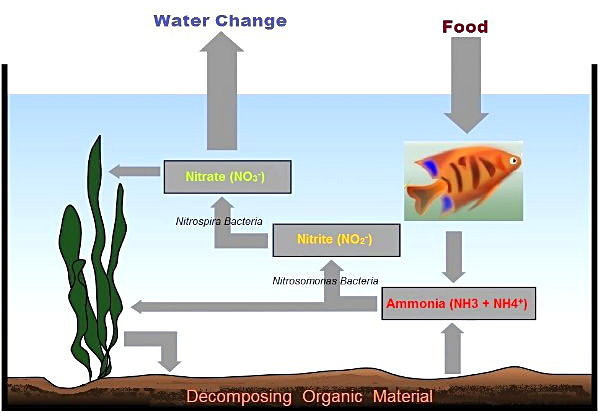Two things worth noting here. First, the fishless cycling guide here is written with the assumption that there are neither live plants nor any seeding of bacteria being used. When either or both are being used it changes everything and the numbers in the article will never appear as expected.
10 Yanks keeps saying he does not cycle and then explains exactly how he cycles. When one seed bacteria they are accelerating a cycle not making it nit needed or not happening. 10 has a lot of bacteria and Archaea at work in his tanks no matter what he tries to say to the contrary.
To prevent a cycle from happening takes a fair amount of effort specifically done to achieve that result.
What Essjay wrote is some of the most accurate information in this thread.
Ammonia exists in 2 forms in water. How much is in the form of ammonia the gas, aka NH# is what metters. There rest of the total ammonia will be ammonium aka NH4. Ammonia at low levels harms and even kills fish. Ammonium need to be present in much higher concentrations and for much more time to harm fish. But it harms them by burning their gills and other body parts (especially the exterior ones), what it doesn't do it enter their blood stream.
So just having total ammonia present doesn't mean it is doing harm especially when it is dropping to 0 on a matter of days. They key to it all is how much total ammonia one tests and then what the specific pH and temperature of the water is. The higher these are, the more of the ammonia will be in the toxic form.
In general, the bacteria and Archaea consume NH3 while plants and algae consume NH4. The actual formula for the ammonium Ion is NH₄⁺. The reason ammonium is less harmful than ammonia is because the size of the NH3 is bigger than NH4 and it cannot pass though the gills and into the bloodstream whereas the NH3 can.
What all of this means for us when we test ammonia levels is whether we need to do anything to deal with it or we can let things continue to proceed naturally without out needing to intervene.
One last note here. When I read or hear people say that their fish were not harmed by elevated ammonia, nitrite or nitrate I tend to think OH Boy!. How does one know what internal damage might have occurred to a fish? How do you know that you have not shortened the life of the fish or made it sterile? You absolutely have no idea about this.
We can no more predict what the lifespan of any one of our fish will be than we can do for any person or animal on the planet. I am 76 and I have no idea when I will die. I can say is I will not be alive 76 years from now. In fact I would bet anybody that this is the case. The only problem is I never be alive to collect on that bet.
I will leave readers with this thought. I have never seen any science which suggests there is a benefit to fish being exposed to lower level of ammonia or nitrite for any length of time. However, there is a way to protect fish from nitrite poisoning by using chloride in the water. Chloride is found in salt which is why nitrite is usually not an issue in SW tanks.
Are nitrites toxic in saltwater?
There are various situations where a temporary increase in nitrite concentration may occur. However, due to the high chloride content, nitrite in seawater is much less harmful than in fresh water. Nevertheless, the value should be observed because it indicates a disturbance in the nitrogen cycle.
The problem with nitrite is that, once inside a fish, it takes time to work its way out. This can be anywhere from 24 to about 72 hours. However, this requires that there not be more nitrite in the water entering the fish. This is why adding salt to FW tank with nitrite is so helpful. It prevents further nitrite from getting inside of a fish which also allows what may already be there to work its way out.
The one thing that is known to help with nitrite inside a fish is Methylene Blue- but this stuff stains anything it touches. Below is from Spruce Pets:
Nitrite or Cyanide Poisoning
As an aid in reversing nitrite (NO2−) or cyanide (CN−) poisoning of marine or freshwater fish, use Methylene Blue in the following application:
- Remove carbon filter and continue to operate with mechanical filter media throughout the treatment period.
- Add 1 teaspoon (5 ml) of 2.303% Methylene Blue per 10 gallons of water. This produces a concentration of 3 ppm. Continue the treatment for 3 to 5 days.
- Make a water change and replace the filter carbon at the conclusion of the treatment.
I would only use the above if nitrite levels are very high and fish are likely going to die. Otherwise, chloride would be the best option, IMO. And then there is this, also from Spruce:
Safe Applications
Methylene Blue can be used with crustaceans, including crabs, shrimp, and snails, but should be introduced carefully. It will damage
live plants at doses over 4 mg/L and should be used with caution in such cases, ensuring that plants are exposed for only limited periods of time.
Methylene Blue should not be used concurrently with Erythromycin or Tetracycline antibiotics. After using a Redox reducing type of water conditioner (which includes most water conditioners), wait for 30 minutes before adding Methylene Blue. Discontinue the use of carbon media in filters while treating, as carbon will remove the Methylene Blue.
The above quotes are from
https://www.thesprucepets.com/methylene-blue-1379926


